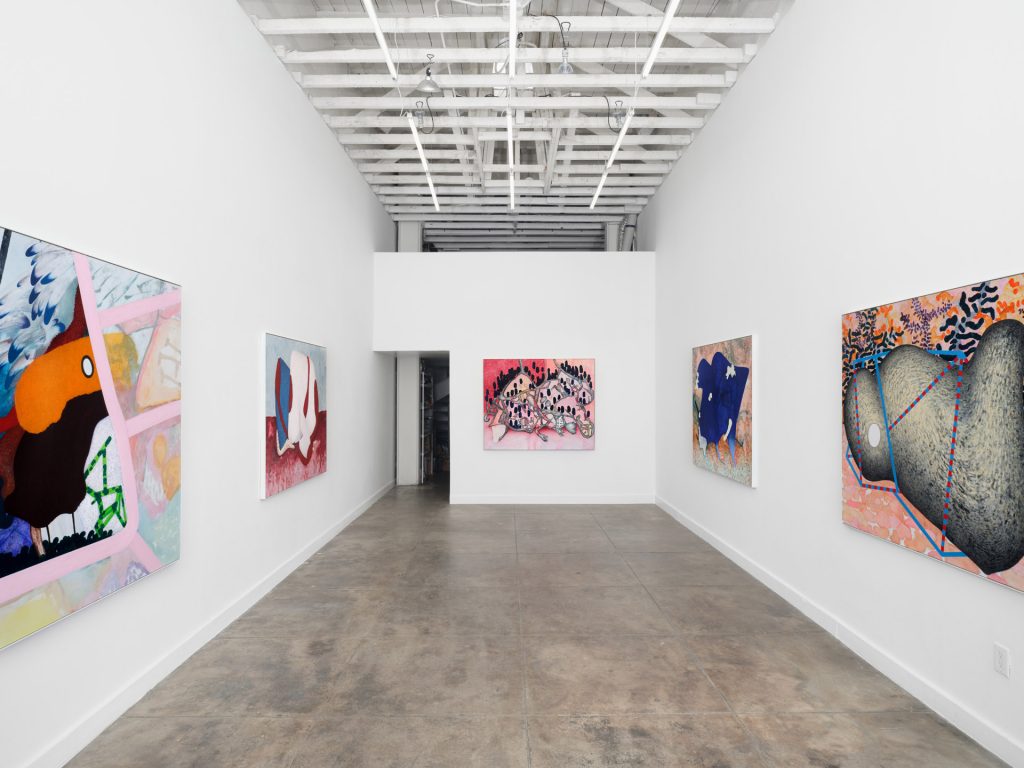
Press Release
Lui Shtini is both a painter, and an engineer of paintings. He approaches the surface of each work like a researcher exploring the peculiarities of a new polymer. For the past few years, he has chosen to work on aluminum composite panel, a material more common to photographic and commercial applications than painting. The paint he applies to each work sits uncomfortably on its surface, recording like a printing plate the minute gestures his hand makes as he pushes it around. The paintings have an uncanny presence, and may have more in common with a photo transfer or a fresco than a work on canvas. Shtini engineers them meticulously, going to painstaking lengths to create moments that might seem to emerge from serendipitous experimentation. His practice defies notions of abstraction or figuration, shifting smoothly between the two, proposing an open-ended language of visual expression. He suggests through nascient forms that a body might be composed of a bare minimum of humanlike features, or might emerge accidentally from a chaotic rending of vessels in motion. These paintings speak more to the odd and universal feeling of embodiment than they do to a specific body. Prying out a loose tooth; waking to find a long stray hair that’s grown overnight; discovering the impression of a seat cushion on the skin—the work is alive with these uncomfortable moments.
Thaw, Shtini’s first exhibition in Los Angeles since 2015, represents an extraordinary development borne of intense contemplation. Concerned fundamentally with humanity’s relationship to the natural world and the supplanting of “nature” itself with a hybridized technological apparatus, Shtini set out to create a visual language shockingly new and yet hauntingly familiar. Like a melted glacier that breaks from its mass to sluice silently into the ocean, or an overflowing grain silo, product of a pandemic-induced supply chain crisis, these paintings offer points of illuminating interface. At the same time, Shtini rejects the categories that define broad swaths of contemporary practice. He teaches us that there can be no “pure abstraction,” that every painting is a record of a performance, of a body in motion. In this way, the composition and the improvisation are one; each work is composed anew, beholden to no prior picture. Here, surface texture is itself a thing that delineates volume and mass, a “fourth axis” that requires a constant circumnavigation by the viewer to be seen properly.
Shtini’s titles are themselves discoveries; the painter “found” extinct animals hiding in the works and borrowed their names, sometimes tweaking, sometimes creating anew. Mammut Americanum features a hulking giant, a fully arrived-at form, not unlike an egg, or perhaps a factory-floor Saturn. A rich red band, less muddy burgundy than its siblings, cuts through the middle of this wooly mass, telling us two stories about its spatial dimensionality. Shtini doesn’t compose in the traditional sense—he doesn’t balance forms to create pleasure, or arrange shapes in a way that holds them in resolved dissonance, either. The chunky textured white elements that snake around the perimeter of Americanum’s “body,” only to emerge later in a casual trio, don’t really do anything in particular. They just belong to the picture, are of and by it. Ursus, another emergent mass, shows us what might again be a being of sorts, caught in an impossible object cage that ensnares its appendages. A curious white oval commands the picture, created by rubbing away paint, so that only the panel’s angry white ground shines through. Coleodonta is another paean to experimentation and the dimensional effects of color. The picture reads like a massive petri dish, due in part to the stippled look of its serpentine corpus. It’s alive with rich blue droplets, glossy and impossibly deep, vibrating hard against fields of pink and yellow, dappled like a reactive emulsion. White bands make their way along these thick, weathered pathways, freeloaders of sorts, and we can imagine them crackling jauntily like the shapes in a Len Lye film, or perhaps the animated segment of a 70s sex education tutorial.
The exhibition’s natural focus, Flood, is a large scale work, predominantly pink, in which a symphony of organic forms are glimpsed through a thick impasto tube that resembles a cellular wall. The painting suggests a surprising depth; its great accomplishment is the effect of frosted glass. On closer inspection, the “foreground” is created by rubbing the paint away, leaving only a buttery surface stained with the memory of color, suggesting that what is close is obscured by familiarity. By working and reworking their flayed surfaces, Shtini saturates these paintings with a kind of glacial inevitability. A thaw comes at the end of winter, marking a shift from a rigid state to a looser one. These pictures emerge from a similarly inscrutable process to stand as magnificent artifacts of our tempestuous world.
Region
Location
-
1819 3rd Avenue, Los Angeles, California 90019, United States


Add a review